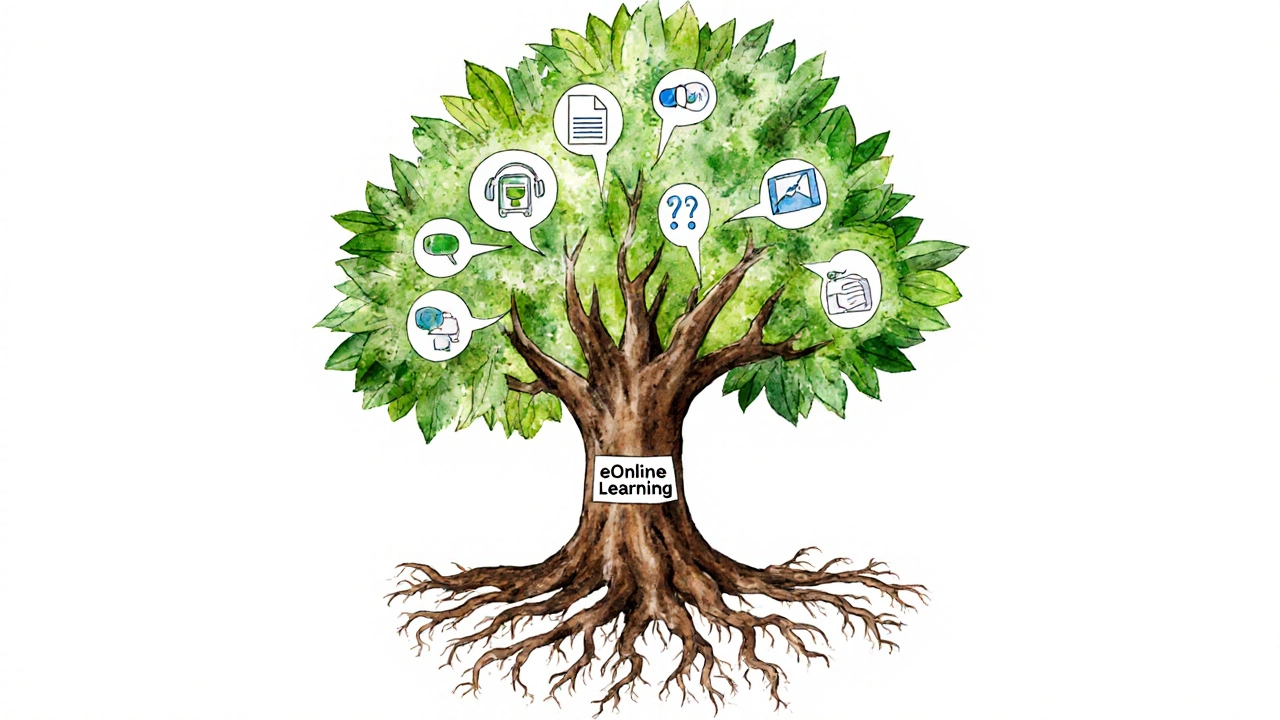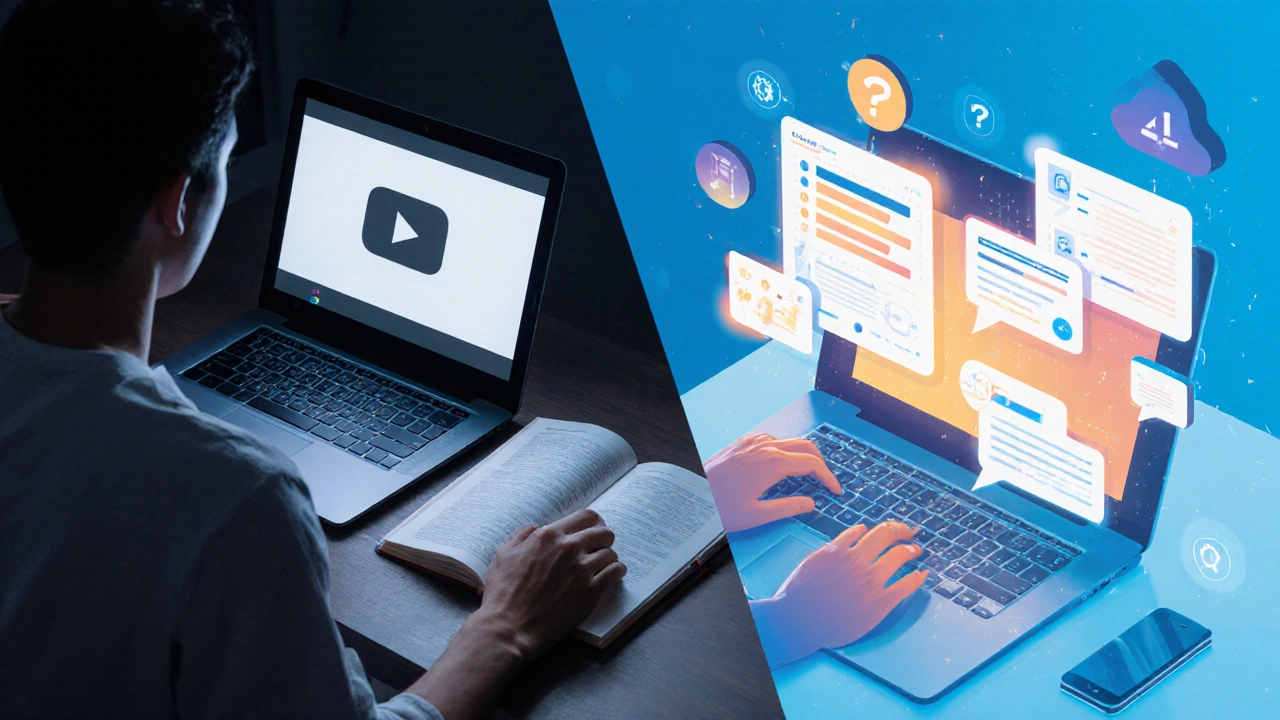eLearning Quality Checker
Is this eLearning or just Online Learning?
Test your learning platform or course against the 5 key criteria from the article. True eLearning requires specific design principles.
Strengths
Weaknesses
People use the terms online learning and eLearning like they’re the same thing. But they’re not. If you’re choosing a course, setting up training for your team, or just trying to understand what’s out there, mixing them up can cost you time, money, and results.
What eLearning Actually Means
eLearning stands for electronic learning. It’s not just about watching videos or reading PDFs online. True eLearning is designed using instructional principles - things like spaced repetition, interactive quizzes, branching scenarios, and adaptive feedback. It’s built to change how people learn, not just deliver content digitally.Think of it like this: a textbook you scan and upload to a website isn’t eLearning. But a course that adjusts its difficulty based on your answers, gives you instant feedback on mistakes, and tracks your progress over weeks? That’s eLearning. Platforms like Coursera, Udemy, and LinkedIn Learning use eLearning design in their best courses. They don’t just host videos - they structure learning experiences.
According to research from the U.S. Department of Education, well-designed eLearning can improve retention by up to 60% compared to traditional lectures. Why? Because it’s interactive, personalized, and often includes practice that mimics real-world tasks.
What Online Learning Really Is
Online learning is broader. It’s any kind of education that happens over the internet. That includes live Zoom classes, YouTube tutorials, webinars, discussion forums, and even email-based lessons. It doesn’t have to be structured, interactive, or even assessed.A university offering a live lecture streamed over Zoom? That’s online learning. A high school student watching a TikTok video explaining algebra? Also online learning. A company sending out a 30-minute PowerPoint PDF via email and calling it "training"? Still online learning.
Online learning is about location. It’s learning that happens remotely. eLearning is about design. It’s learning that’s engineered for effectiveness.
The Overlap - And Why It Confuses People
There’s definitely overlap. Most eLearning happens online. So all eLearning is online learning - but not the other way around.Imagine a cooking class. If you’re watching a video of a chef chopping onions on YouTube, that’s online learning. If the same video includes a quiz after each step, asks you to upload a photo of your own chopping technique for feedback, and then recommends the next lesson based on your performance? That’s eLearning.
The confusion comes from marketing. Companies slap "eLearning" on anything digital to sound smarter. But if your "eLearning" platform just plays videos with no interaction, no assessments, and no personalization - you’re paying for online learning disguised as eLearning.
How to Tell Them Apart in Practice
Here’s a quick checklist to spot the difference:- Does it ask you to do something? Click, answer, record, submit? That’s eLearning.
- Does it change based on your answers? If you get a question wrong, does it explain why and give you a different path? That’s eLearning.
- Is there feedback? Real feedback - not just "Correct!" - but suggestions, tips, or comparisons? That’s eLearning.
- Is it just a video or PDF? If yes, and there’s no interaction beyond watching or reading - that’s online learning.
- Does it track progress over time? eLearning platforms usually have dashboards showing completion rates, quiz scores, and skill growth.
If you’re buying a course for your team, ask: "Will this actually improve performance?" If the answer is "It’s just videos," you’re getting online learning. If they show you how it adapts, assesses, and reinforces skills - you’re getting eLearning.
Why It Matters for Businesses and Learners
For companies, the difference affects ROI. A 2024 study by ATD found that organizations using true eLearning saw a 42% higher completion rate and 35% faster skill application than those using basic online courses.For learners, it’s about results. You can watch a hundred YouTube tutorials on Excel. But if you need to pass a certification or use Excel daily at work, you need a course that tests you, corrects your mistakes, and builds muscle memory. That’s eLearning.
Think about language learning. Duolingo isn’t just a bunch of videos. It uses spaced repetition, gamified feedback, and adaptive algorithms to keep you engaged. That’s eLearning. A free language class on YouTube? That’s online learning.

What to Look For When Choosing a Platform
Don’t be fooled by buzzwords. Here’s what to actually check:- Assessments: Are there quizzes, simulations, or real tasks? Or just "end-of-module" multiple-choice tests?
- Adaptivity: Does the platform adjust content based on your performance?
- Feedback: Is feedback automated and specific? Or just "Good job!"?
- Progress tracking: Can you see skill improvement over time, not just completion?
- Mobile experience: Does it work offline? Can you practice on the go?
Platforms like EdApp, TalentLMS, and Moodle (when properly configured) are built for eLearning. YouTube, Vimeo, or basic LMS setups that just host files? They’re online learning tools.
Bottom Line
Online learning is about where you learn. eLearning is about how you learn.If you want real change - better skills, higher retention, measurable results - you need eLearning. If you just need to watch something remotely, online learning works fine.
Stop treating them as synonyms. The next time someone says "our eLearning platform," ask: "What makes it eLearning?" If they can’t answer, you’re not getting what you think you are.
Is online learning the same as eLearning?
No. Online learning means any education delivered over the internet - like watching a video or attending a live Zoom class. eLearning is a specific type of online learning that uses instructional design principles: interactive quizzes, personalized feedback, adaptive content, and progress tracking. All eLearning is online, but not all online learning is eLearning.
Can a YouTube video be considered eLearning?
Only if it’s part of a structured system. A single YouTube video with no quizzes, no feedback, and no way to track your progress is online learning. But if that video is embedded in a platform that asks you questions after watching, gives you feedback on your answers, and adjusts future lessons based on your performance - then yes, it’s part of an eLearning experience.
Why do companies call everything "eLearning"?
It’s a marketing tactic. "eLearning" sounds more professional, tech-savvy, and effective than "online course" or "video training." Many companies use the term to justify higher prices, even when their platform just hosts static files or recordings. Always check the features - not the label.
What’s the biggest mistake people make when choosing eLearning?
Assuming that if it’s digital, it’s effective. Many platforms look modern and flashy but offer no interaction, no feedback, and no personalization. The real test: does it change how you learn? If you’re just consuming content without doing anything, you’re not getting eLearning.
Do I need special software to use eLearning?
Not usually. Most eLearning platforms work in any modern web browser. Some may require a smartphone app for mobile practice, but you don’t need special hardware. What matters is the design - not the device. A good eLearning course works on a tablet, laptop, or phone - as long as it includes interaction and feedback.
